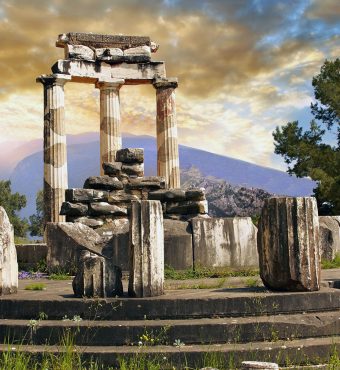Corinth – Mycenae

We will drive you to the city of Corinth, where you will cross the Corinthian Canal and visit the Archaeological Site of Ancient Corinth! After that you will walk through Mycenae, the city of Agamemnon, who was king of all Greeks during the Trojan War, and realize that Homers Heliad and Odyssey describe real historical events!
We will drive you to the city of Corinth, where you will cross the Corinthian Canal and visit the Archaeological Site of Ancient Corinth! After that you will walk through Mycenae, the city of Agamemnon, who was king of all Greeks during the Trojan War, and realise that Homers Heliad and Odyssey describe real historical events!
Corinthian Canal, Corinth, Archaeological Site of Ancient Corinth, Acrocorinth, Citadel of Mycenae, Archaelogical Museum of Mycenae, Tomb of Agamemnon, Hill of Tiryns
The tour starts from the Corinthian Canal: the idea for the canal, which connects the Saronic to the Corinthian gulf, was conceived by Periander (6th century B.C.); however, the canal was finally opened after Greece’s independence, during the period 1882-1893. It has a length of 6,346 metres, a width of 24.6 metres at sea level and a depth of 8 metres.
In antiquity Corinth was one of the largest and most important cities in Greece. It played a significant part during the Peloponnesian War and after 200 B.C it became the capital of the Achaean Confederation. Under Julius Caesar it was elevated to the capital of the Achaia province. During the middle Ages it was associated with its impressive fortifications at Akrokorinthos (Acrocorinth). A powerful earthquake destroyed the city in 1858, which was rebuilt with good earthquake resistant specifications on a good town plan, 9 km to the north of the ancient city.
The Archaeological Site of Ancient Corinth is 9 km north-west of the modern city. You can see the ruins at Pirini fountain, the courtyard of Apollo, the foundations of a significant Roman basilica, the temple of the goddess Tyche (Fortune) or Apollo Klarios, the stores in the agora, the temple of Apollo, the ruins of the theatre and the Lerna fountain. The town of Acrocorinth, at whose foot the ancient city was built, dates to circa 4000 B.C. The Archaeological Museum operates at the archaeological site (built in 1931-32) with an exhibition collection dating from the Prehistoric Period through to the Roman and Byzantine Period. It is worth seeing the large Mycenaean crater (vessel) (circa 1200 B.C.), the Corinthian amphora and stopper (600 B.C.) etc.
The tour continues in Mycenae that is an ancient city in the Peloponnese, 140 km from Athens. Until 1871, when Heinrich Schliemann, a German pioneer of Archaeology, discovered Troy, the famous Trojan War, narrated by Homer in Heliad, was just a myth. Schliemann brought again to light, not only Mycenae, but also proved with the finds of his excavations the interaction between Greeks and Trojans.
The earliest archaeological fragments indicate that the site of Mycenae was inhabited since the 7th millennium BC, from prehistoric times. Agamemnon and Menelaus, Danae and Perseus, Pelops and Atreus are the apparent forefathers of all of Europe, and the birthplace of all of these historical figures, is golden Mycenae.
The Citadel of Mycenae is the core fortified area of the city and served both as an observatory area and as the centre of actions of the city’s defenders, in cases of enemies’ attack. The Archaelogical Museum of Mycenae is built next to the citadel. While the most important Mycenaean artifacts are exhibited at the National Archaeological Museum of Athens, a variety of other objects unearthed in the vicinity are exhibited in its three halls. It provides context to the excavations and it is easily visited after a tour of the archaeological site. The Tomb of Agamemnon is the best example of a tholos tomb in existence. It was built partly into a hill, and its dromos (path to the entrance) is impressive and well preserved. According to the Greek traveler of antiquity, Pausanias, the people of his day (2 C BC) believed that the tholos graves were treasure stores. This is why it is known as a Treasury, and although it may originally have contained treasure, it was just a grave, when archaeologists discovered it. The fortification, built on the Hill of Tiryns, in order to protect the palace complex, is such an impressive construction that the ancient Greeks could not believe that it was built by human hands. All the great heroes with supernatural powers are associated with Tiryns: Bellerophon, Perseus, and Hercules. Indeed, the construction of the wall is unbelievable and a challenge to logic, even for today’s visitors. One stands in awe in front of the perfect assembly of these huge boulders, unable to understand either how or who could have performed such a great feat of engineering.
Finally, we will drive you back to where we started.
- 4 Persons Max / Car
- 9 Hours
- 230 € Price / Car
- Free Wi-fi
- Free cold water
- AC
- Licensed Driver
- Knowledgeable Driver
Explore more Daily Tours
Day Tours • explore_tours
Athens at a glance
Day Tours • explore_tours
Cape Sounion Tour
Day Tours • explore_tours
Corinth Tour
Day Tours • explore_tours















